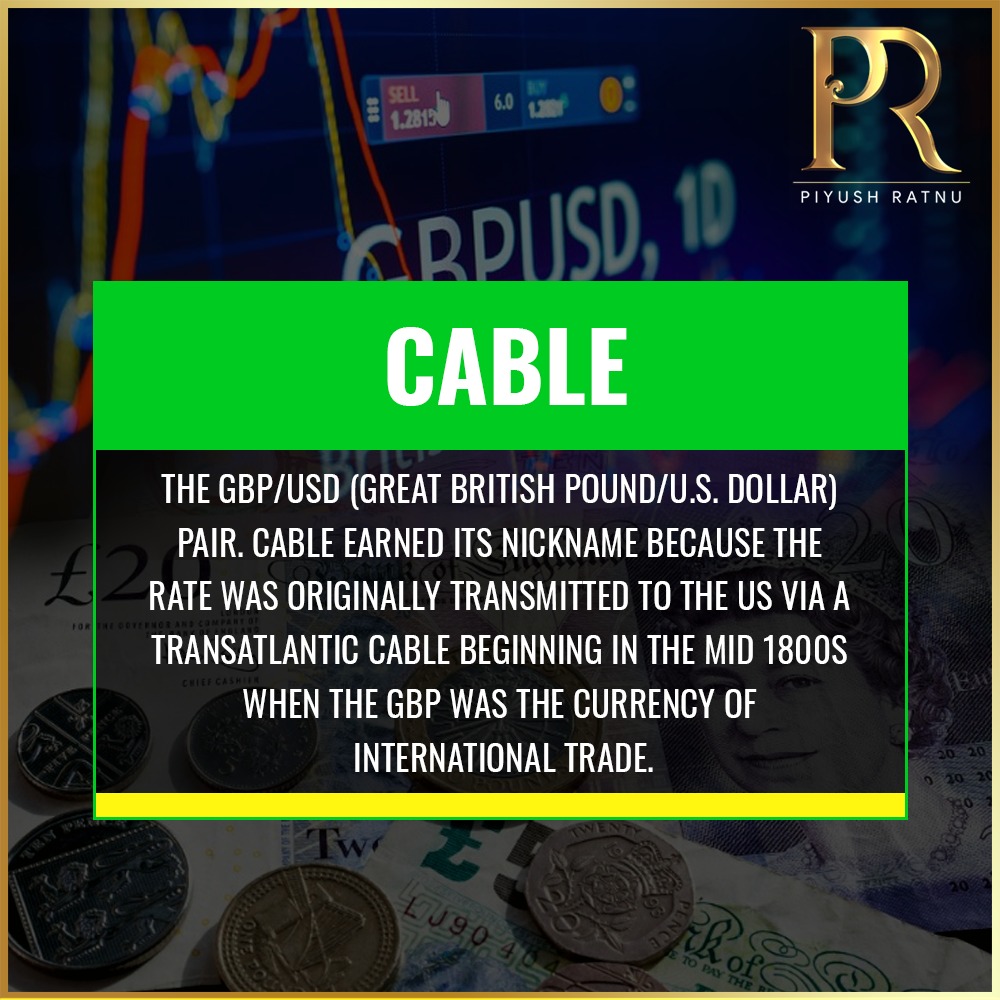CABLE: The GBP/USD (Great British Pound/U.S. Dollar) pair. Cable earned its nickname because the rate was originally transmitted to the US via a transatlantic cable beginning in the mid 1800s when the GBP was the currency of international trade.

CAD: The Canadian dollar, also known as Loonie or Funds.

CALL OPTION: A currency trade which exploits the interest rate difference between two countries. By selling a currency with a low rate of interest and buying a currency with a high rate of interest, the trader will receive the interest difference between the two countries while this trade is open.

CANADIAN IVEY PURCHASING MANAGERS (CIPM) INDEX: A monthly gauge of Canadian business sentiment issued by the Richard Ivey Business School.

CANDLESTICK CHART: A chart that indicates the trading range for the day as well as the opening and closing price. If the open price is higher than the close price, the rectangle between the open and close price is shaded. If the close price is higher than the open price, that area of the chart is not shaded.

CAPITULATION: A point at the end of an extreme trend when traders who are holding losing positions exit those positions. This usually signals that the expected reversal is just around the corner.

CARRY TRADE: A trading strategy that captures the difference in the interest rates earned from being long a currency that pays a relatively high interest rate and short another currency that pays a lower interest rate. For example: NZD/JPY (New Zealand Dollar/Japanese Yen) has been a famous carry trade for some time. NZD is the high yielder and JPY is the low yielder. Traders looking to take advantage of this interest rate differential would buy NZD and sell JPY, or be long NZD/JPY. When NZD/JPY begins to downtrend for an extended period of time, most likely due to a change in interest rates, the carry trade is said to be unwinding.

CASH MARKET: The market in the actual underlying markets on which a derivatives contract is based.

CASH PRICE: The price of a product for instant delivery; i.e., the price of a product at that moment in time.

CBS: Abbreviation referring to central banks.

CENTRAL BANK: A government or quasi-governmental organization that manages a country’s monetary policy. For example, the US central bank is the Federal Reserve and the German central bank is the Bundesbank.

CFDS*: A Contract for Difference (or CFD) is a type of derivative that gives exposure to the change in value of an underlying asset (such as an index or equity). It allows traders to leverage their capital (by trading notional amounts far higher than the money in their account) and provides all the benefits of trading securities, without actually owning the product. In practical terms, if you buy a CFD at $10 then sell it at $11, you will receive the $1 difference. Conversely, if you went short on the trade and sold at $10 before buying back at $11, you would pay the $1 difference.

CHARTIST: An individual, also known as a technical trader, who uses charts and graphs and interprets historical data to find trends and predict future movements.

CHOPPY: Short-lived price moves with limited follow-through that are not conducive to aggressive trading.

CLEARED FUNDS: Funds that are freely available, sent in to settle a trade.

CLEARING: The process of settling a trade.

CLOSED POSITION: Exposure to a financial contract, such as currency, that no longer exists. A position is closed by placing an equal and opposite deal to offset the open position. Once closed, a position is considered squared.

CLOSING: The process of stopping (closing) a live trade by executing a trade that is the exact opposite of the open trade.

CLOSING PRICE: The price at which a product was traded to close a position. It can also refer to the price of the last transaction in a day trading session.

COLLATERAL: An asset given to secure a loan or as a guarantee of performance.

COMMISSION: A fee that is charged for buying or selling a product.

COMMODITY CURRENCIES: Currencies from economies whose exports are heavily based in natural resources, often specifically referring to Canada, New Zealand, Australia and Russia.

COMPONENTS: The dollar pairs that make up the crosses (i.e., EUR/USD + USD/JPY are the components of EUR/JPY). Selling the cross through the components refers to selling the dollar pairs in alternating fashion to create a cross position.

COMPX: Symbol for NASDAQ Composite Index.

CONFIRMATION: A document exchanged by counterparts to a transaction that states the terms of said transaction.

CONSOLIDATION: A period of range-bound activity after an extended price move.

CONSTRUCTION SPENDING: Measures the amount of spending towards new construction, released monthly by the U.S. Department of Commerce’s Census Bureau.

CONTAGION: The tendency of an economic crisis to spread from one market to another.

CONTRACT: The standard unit of forex trading.

CONTRACT NOTE: A confirmation sent that outlines the exact details of the trade.

CONTRACT SIZE: The notional number of shares one CFD represents.

CONTROLLED RISK: A position which has a limited risk because of a Guaranteed Stop.*

CONVERGENCE OF MAS: A technical observation that describes moving averages of different periods moving towards each other, which generally forecasts a price consolidation.

CORPORATE ACTION: An event that changes the equity structure (and usually share price) of a stock. For example, acquisitions, dividends, mergers, splits and spinoffs are all corporate actions.

CORPORATES: Refers to corporations in the market for hedging or financial management purposes. Corporates are not always as price sensitive as speculative funds and their interest can be very long term in nature, making corporate interest less valuable to short-term trading.

COUNTER CURRENCY: The second listed currency in a currency pair.

COUNTERPARTY: One of the participants in a financial transaction.

CPI: Acronym for Consumer Price Index, a measure of inflation.

CRATER: The market is ready to sell-off hard.

CROSS: A pair of currencies that does not include the U.S. dollar.

CROWN CURRENCIES: Refers to CAD (Canadian Dollar), Aussie (Australian Dollar), Sterling (British Pound) and Kiwi (New Zealand Dollar) – countries off the Commonwealth.

CTAS: Refers to commodity trading advisors, speculative traders whose activity can resemble that of short-term hedge funds; frequently refers to the Chicago-based or futures-oriented traders.

CURRENCY: Any form of money issued by a government or central bank and used as legal tender and a basis for trade.

CURRENCY PAIR: The two currencies that make up a foreign exchange rate. For example EUR/USD (Euro/U.S. Dollar).

CURRENCY RISK: The probability of an adverse change in exchange rates.

CURRENCY SYMBOLS: A three-letter symbol that represents a specific currency. For example, USD (U.S. Dollar).

CURRENT ACCOUNT: The sum of the balance of trade (exports minus imports of goods and services), net factor income (such as interest and dividends) and net transfer payments (such as foreign aid). The balance of trade is typically the key component to the current account.

